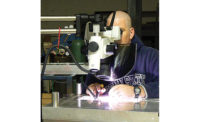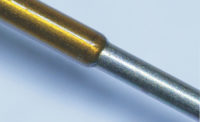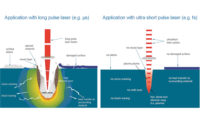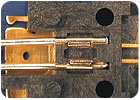
As copper ribbon and wire for electronic assemblies get below 0.004 inch thick, joining processes such as crimping, soldering and brazing become less viable due to low joint conductivity and joint reliability issues. Micro welding doesn’t have these limitations.
However, because copper has such high thermal conductivity, heat disburses rapidly from the joint, making it difficult to maintain heat balance and weld the parts reliably. This problem is exacerbated by high production rates, small part sizes, dissimilar materials and dissimilar part thicknesses. The challenge of micro welding copper is how to control the heat balance without over- or underheating the parts.
Micro welding can be done with ultrasonic, resistance and laser welding equipment. Each has its advantages and disadvantages.
An ultrasonic welder applies vibration energy at the joint interface to join the parts. The vibration energy is delivered to the interface by a sonotrode, or horn, that contacts the top part. The horn vibrates at frequencies of hundreds to thousands of times per second, with motion amplitude of 0.0005 to 0.004 inch. The underside of the part is supported with an anvil, which can be static or vibrating.
The vibratory action under applied force causes plastic deformation of surface disparities and oxides at the weld interface, leading to highly intimate contact and a diffusing of metallic atoms. The joint forms by diffusion, and there is no melting at the joint. There is some deformation or thickness reduction of the parts, but this can be controlled. Contact of the horn with the part is maintained by force and friction, which is enhanced by a knurled pattern on the horn.
Ultrasonic welding is well-suited to welding sheets of conductive metals, including aluminum and copper. However, the process has some drawbacks for micro welding. Since force is applied to the parts, mechanical contact is required on both sides of the joint. Joint geometry is mostly limited to lap welds, and the process is not as fast as other welding methods.
Resistance welding relies on high resistance at the joint interface to create heat as current is passed through the parts. The circuit is created by electrodes that contact the part either from the same side or opposite sides of the workpiece. Electrical contact is assured by exerting some force on the parts.
When resistance-welding conductive parts, the electrodes are resistive and therefore perform two functions: They heat up the parts, and they conduct current to enable heating to occur at the joint interface.
Resistance welding works well for a variety of applications and materials. However, since the process relies on mechanical contact and the need to create an electrical circuit between two electrodes, it may not work correctly in all circumstances, especially if the parts are mechanically delicate. In addition, the minimum electrode size is around 0.04 inch in diameter, which may limit joint accessibility.
Laser welding is a noncontact process, requiring access to only one side of the assembly. The technology is useful for working on extremely small joint areas, and can be used to weld different shaped parts, different joint geometries, and dissimilar materials. It requires no consumables, and the weld cycle is measured in milliseconds.

At a wavelength of 1,064
nanometers, an Nd:YAG laser produces inconsistent spot welds on bare copper, even burning a hole through the assembly. At a wavelength of 532
nanometers, the laser produces much more consistent results, as this photo shows.
Green Lasers
On the face of it, laser welding appears to be an excellent solution for micro welding copper-but there is a problem. The pulsed Nd:YAG (neodymium-doped yttrium aluminum garnet) laser used for most micro welding applications has a wavelength of 1,064 nanometers, and copper reflects more than 90 percent of its energy.Extremely high power is required to overcome the reflectivity and ensure that sufficient light energy is delivered to the copper. Ironically, once enough laser power is delivered to raise the temperature of the copper, its reflectivity decreases. In less than a billionth of a second, there is a rapid change in how much power the copper absorbs. The high power that was initially required now far exceeds what is required to form the weld. As a result, the material rapidly overheats and vaporizes, leaving a large hole.
Numerous techniques have been used to overcome this reflectivity, such as shaping the laser pulse, adding oxygen, and applying a less reflective plating.
Pulse shaping is not reliable. Because the reflectivity of copper and other conductive parts varies, the precise moment at which the laser power should be reduced also varies. There have been some attempts to better anticipate this moment by implementing feedback techniques, but none have so far proven viable.
Oxygen has been shown to dramatically increase laser penetration when seam welding copper, because it builds up an oxide layer on the part. However, this has not been effective for spot welding applications, because the positive effect of oxygen is seen only after several pulses in succession. As a result, it’s not reliable for welding single spots or short seams.
Using less reflective coatings such as nickel or tin does help to reduce initial reflection, but does not fully alleviate the problem. Large energies are still required to get energy into the copper. As a result, the process window for micro welding becomes very small.
One technique that does overcome surface reflectivity issues with copper is to reduce the light wavelength from 1,064 to 532 nanometers. The 532-nanometer, or green, wavelength enables consistent energy absorption into the copper and stabilizes welding. At a wavelength of 532 nanometers, an Nd:YAG laser penetrates uncoated copper as well as a 1,064-nanometer laser penetrates steel.
This wavelength can be achieved in two ways. The most common is to use a q-switched laser, but such a laser does not have sufficient pulse energy to weld.
A more novel approach is to use a regular pulsed Nd:YAG laser delivered through a fiber. This setup offers 532-nanometer light at a peak power of 1.5 kilowatts and pulse width of up to 5 milliseconds. This provides enough energy to penetrate copper to a depth of approximately 350 microns, which is sufficient for most micro welding applications. An added benefit of using a pulsed Nd:YAG laser delivered through a fiber is that the beam has low brightness. This promotes even absorption across the focus spot, preventing hot spots at the center of the weld that may cause process instability.
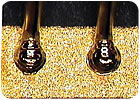
Green lasers can weld
solid 0.004-inch diameter gold wire to
gold-plated metalized pads.
Real World Examples
Micro welded connections can be found in automotive sensors, implantable medical devices, and telecommunications equipment.A common application in the electronics industry is to weld a 0.015-inch thick, gold-coated copper ribbon to metalized pads. Ideally, the pad should be at least 1.5 times the thickness of the ribbon. This will create a good thermal balance between the wire and the pad, preventing the pad from overheating.
Joining solid and stranded wires is another common application in electronics. By suitably pointing the laser at the tip of the wire and the pad, the wire is effectively reflowed on the pad, without the heat affecting the pad itself.
Green Nd:YAG lasers have been used to weld solid 0.004-inch diameter gold wire to gold-plated metalized pads and stranded 0.01-inch diameter silver wire to nickel-plated copper terminals. The key in welding stranded wire is maintaining the tip to ensure the strands are closely packed. This can be achieved by compacting, dipping in a plating, or using a short cut-back distance to the insulation.
The flexibility of the green laser is valuable for welding different joint geometries and terminal shapes. For example, the laser can weld a gold-plated copper connector of rectangular cross section to a silver-plated copper wire. The weld is made in a butt configuration. Despite some variation in the position of the wire in relation to the terminal, and some variation in the gap between the round edge of the wire and the square edge of the terminal, the controlled and consistent absorption of laser light by both parts enables the weld to be made reliably.
For high-volume production, welding multiple joints on lead frames is all about quality and speed. Being a noncontact process, laser welding lends itself to high-volume manufacturing. It can execute many welds per second, depending on the motion control system.
Smart cards, radio frequency identification tags and other electronics applications that require less than 50 milliampere-hours of energy generally use either lithium ion or lithium polymer batteries. Connecting the battery terminal in these applications can be challenging. Each terminal is made of copper and aluminum, which are difficult to weld. The terminal material is also very thin, sometimes less than 0.001 inch.
In some applications, ultrasonic welding is used, but laser welding is also an option, and may be especially well-suited to joining terminals to the metalized pads of a circuit board.
When welding materials with different levels of absorption, there is a tendency to overheat the more absorptive materials, causing excessive spatter and porosity. This is usually overcome by favoring one material. However, for small parts, this may not be sufficient, because even the tiniest absorption imbalance can create an overheated weld. At the 532-nanometer wavelength, the reflectivity of both parts becomes closer. As a result, the weld energy balances more consistently, significantly improving weldability.

This photo
shows a seam weld between aluminum and titanium. With the green laser, there’s
no need to favor one of the materials.
